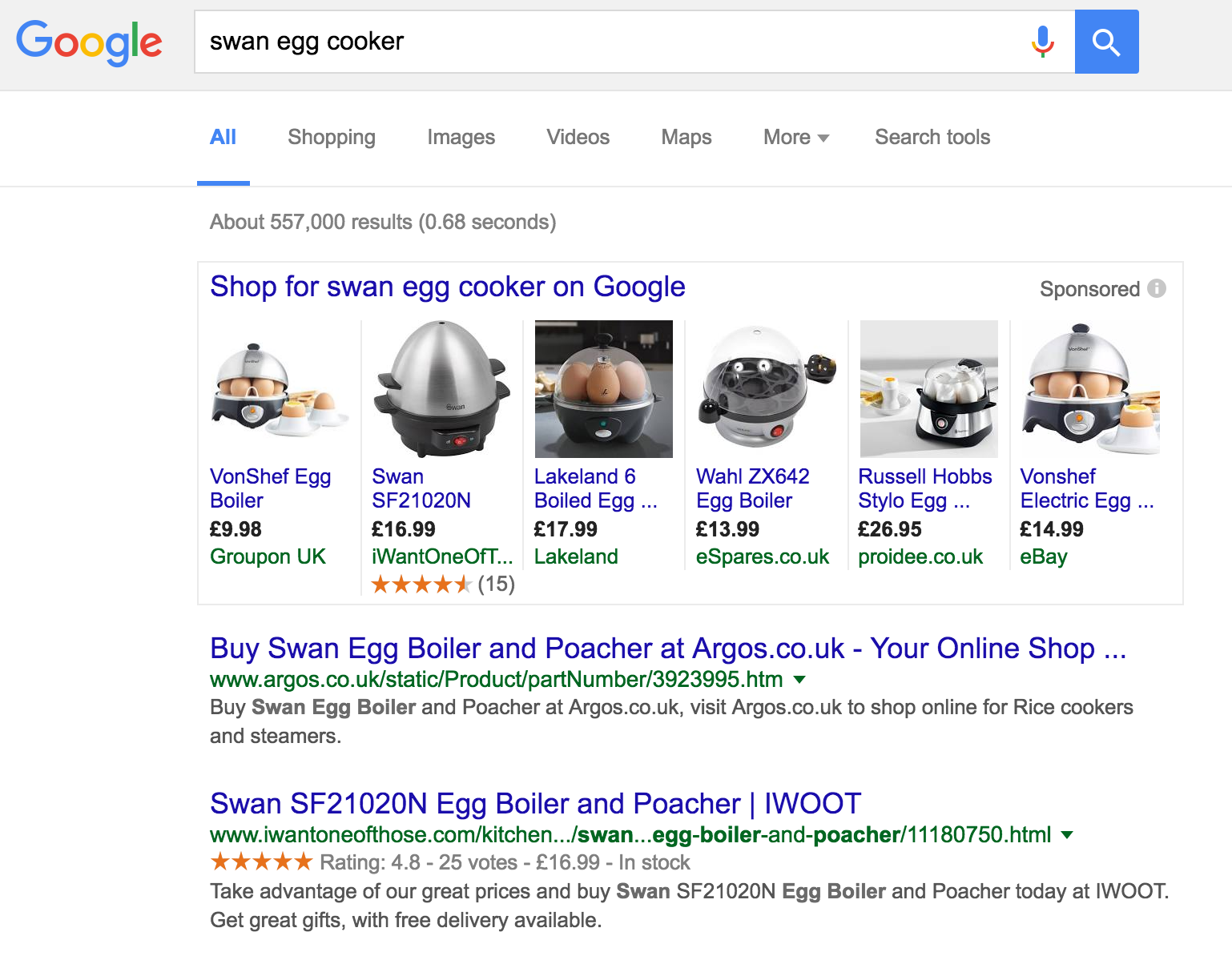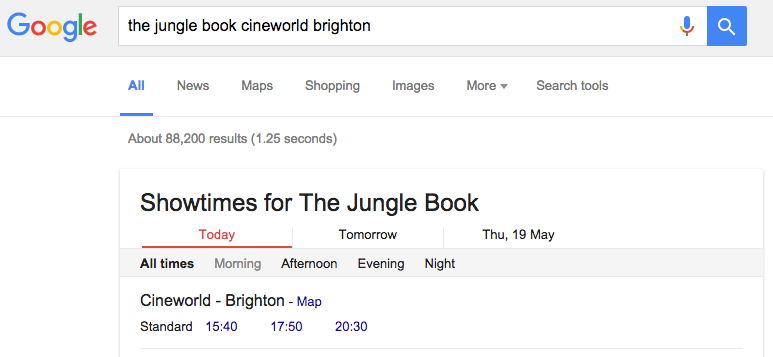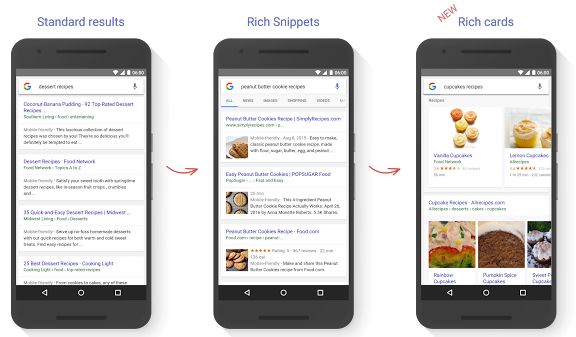Ranking on Google’s first page simply isn’t enough anymore. Structured data markup, Rich Snippets; they’ve been around for some time now but many (including the big brands) fail to implement them. It’s near impossible to think of a vertical that isn’t marred by competition, and with similar companies offering the same product, it can become confusing for a user when turning to Google to start their purchase or booking journey.
In this post we analyse the ways in which SEOs and Webmasters can ensure they’re doing all they can to stand out in Google’s search results and earn that coveted click.
What is structured data markup?
Google defines its “structured data markup” with the following:
“Structured data markup” is a standard way to annotate your content so machines can understand it. When your web pages include structured data markup, Google (and other search engines) can use that data to index your content better, present it more prominently in search results, and surface it in new experiences like voice answers, maps, and Google Now.
This basically means that by utilising a set of tags called Schema on site you’re able to provide a user with more detail about your product or service when appearing in search results. Detail of the language used in these tags can be found at Schema.org along with full listing of the tags available. It can also give the user the capability to explore your site with more knowledge of what’s on offer as well as freedom to do so through the use of effective navigation. You will definitely have seen some form of structured data markup when using Google for pretty much anything. Structured data markup refers to Rich Snippets, Breadcrumbs, or a Sitelinks Search Box:
Our main focus here is Rich Snippets. These include elements such as reviews and pricing that provide further detail to a product or establishment, which in the realm of e-commerce really help a site stand out in the crowd. Reviews can either be provided by the site’s review platform or third parties such as Tripadvisor. Below we have a search result for local pub, William IV in Brighton:

As with many searches such as this, Tripadvisor features in the number one spot. The third line of the result is where Tripadvisor has used rich snippets to tag reviews. Star rating, reviewer’s name (if they’d left one) and date of review appear here.
If a site knows it’s price point for a product is exceptionally competitive, it makes sense for them to have the price of that product tagged and featuring within their search result:

Here we see search results for a Swan Egg Cooker. I Want One Of Those (IWOOT) ranking in position 2 has really stepped up here on it’s organic listing. Not only have they tagged their onsite reviews, they’ve also tagged their pricing and stock levels, creating a natural draw to the listing.
Other Rich Snippets
Moving away from the e-commerce tags, rich snippets offer websites an opportunity to provide their users with immediate access to important data. Cinema times is a great example of this, with authoritative data being used in knowledge tables at the top of Google’s results, negating the need for the user to click through to site.

But why would a site do this if its purpose is to drive traffic?! The short answer to this is that Google is forever trying to assist users when finding the content they’re seeking. If it can instantly serve this content with a certainty of user satisfaction then it is succeeding with that goal.
Recipes! If you’re a keen cook and often use Google to find recipes then you’ll have seen rich snippet markup in action. These tags enable cooking sites to include extremely helpful elements like cooking times and images as well as ratings and ingredients:

Rich Cards
Google’s hot off the press recent evolution of movie and recipe rich snippets is a real progression for mobile users. Announced by Google on Wednesday 18th May, these ‘Rich cards’ see data presented as a host carousel, with multiple results for the user to swipe left or right through (sound familiar?), giving yet more useful information to the user immediately. For the moment rich cards are being rolled out on recipe and movie related search results only, but it will be interesting to see how Google progresses rich cards.
Industries like travel, where a user typically has a longer booking journey would benefit from being able to display package holiday deal cards in search results. These could contain information such as lowest price, accommodation star ratings, weather and an image for multiple holiday packages from the same supplier. This gives the user an immediate indication of what to expect from their desired location and indeed the website before they click through.

More on Rich cards can be found here.
What type of markup should I be using?
The type of product or service you offer will greatly determine what markup you use. For e-commerce sites whose main aim is to sell products or services, rich snippet markups such as product reviews or pricing seem obvious, but consider other options that will help boost your attractiveness in the SERPs. The previously mentioned stock levels or product weight and other measurements are a great way of staying ahead of the competition. For companies that have physical stores for customers to visit, rich snippet tags such as contact information and opening hours really assist the user, especially if they’re trying to find the store in a hurry on a mobile device.
Schema.org is your first point of call here. The site offers full details of all tags that can be implemented on your site.
Structured data markup isn’t limited to product or service information. Perhaps a more commonly seen markup is Breadcrumbs, these indicate to the user where the page their visiting is situated on the site. This becomes extremely useful on large sites where navigation can potentially be an issue.

An impressive option with markup, although slightly harder to set up, is the Sitelinks search box. This requires implementing a functioning search engine on site, tagging it with the relevant Schema.org markup and allowing Google the time to make an assessment on whether it will appear in search results. These typically appear for brand searches where a site’s homepage has historically ranked first. This search box makes it extremely easy for users to navigate a site and is applicable to a range of sites such as e-commerce, news and other knowledge-based sites. Full details from Google can be found here.

How do I implement structured data markup?
As mentioned, structured data markup involves tagging the content on your site with Schema that Google’s crawlers are able to read and understand.
Focussing on an e-commerce environment, the below example shows how a page’s content could be tagged to include pricing and reviews for a lawnmower made by fictional company, Harris Gardening Supply Co in Google’s search results:
Description of the product:
[color-box color="gray”]<div itemscope itemtype="http://schema.org/Product"> <span itemprop="brand">Harris Gardening Supply Co</span> <span itemprop="name">Lawnmower</span>
<span itemprop="description">This professional grade lawnmower offers multi speed action for all your grass cutting needs. </span>[/color-box]
Average rating of the product:
[color-box color="gray”]Product #: <span itemprop="mpn">925872</span>
<span itemprop="aggregateRating" itemscope itemtype="http://schema.org/AggregateRating">
<span itemprop="ratingValue">3.1</span> stars, based on <span itemprop="reviewCount">65
</span> reviews </span>[/color-box]
Price and stock information for the product:
[color-box color=”gray”]<span itemprop=”offers” itemscope itemtype=”http://schema.org/Offer”> Regular price: £300 <meta itemprop=”priceCurrency” content=”GBP” /> $<span itemprop=”price”>300</span> Available from: <span itemprop=”seller” itemscope itemtype=”http://schema.org/Organization”> <span itemprop=”name”>Harris Gardeing Supply Co</span> </span> <link itemprop=”availability” href=”http://schema.org/InStock”/>In stock! Order now!</span> </span> </div> [/color-box]
For sites hosted on WordPress there are a number of great plugins that can take care of this markup, All In One Schema.org Rich Snippets being our favourite.
To conclude
Spending the resource on creating individualised meta descriptions for each product or holiday destination across massive sites isn’t an option. Structured data markup, particularly Rich Snippets, provide a boost to an otherwise generic search result and really give the searcher a reason to click through to your site.
For now, it’s an often overlooked resource for web masters and SEOs, and one that is simple to implement. As a user who often makes purchases online, rich snippets definitely make a difference to my intent, especially on searches for competitive items.


